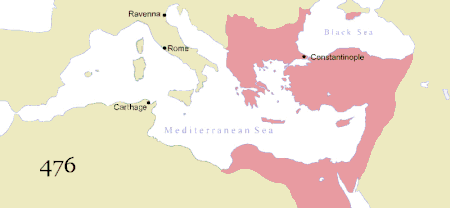| Byzantine culture |
|---|
 |
The population of the Byzantine Empire encompassed all ethnic and tribal groups living there, mainly Byzantine Greeks, but also Armenians, Slavs, Goths, Arabs, Assyrians, Tzans and other groups. It fluctuated throughout the state's millennial history. The reign of the Emperor Justinian I in the mid-sixth century was the high point of the empire's expansion;[1] however, the arrival of plague in 541 AD and its subsequent recurrences caused a severe depletion of the population.[2] After the reign of Emperor Heraclius (r. 610 – 641 AD) and the loss of the empire's overseas territories, Byzantium was limited to the Balkans and Anatolia. When the empire began to recover after a series of conflicts in the 8th century and its territories stabilized, its population began to recover. By the end of the 8th century the population of the empire was around 7,000,000, a figure that climbed to over 12,000,000 people by 1025 AD.[3] The numbers began falling steadily to 9,000,000 people at 1204 AD and even lower to 5,000,000 people at 1282 AD with the arrival of the Turks.[4]
Population estimates

| Year | Population (estimated) | Notes | Area (km2; estimated) | Population density (per km2; estimated) |
|---|---|---|---|---|
| 300 | 18,000,000[5] | Roman East | 2,000,000 | 9 |
| 311 | 17,000,000[5] | Roman East | 2,100,000 | 8.1 |
| 457 | 16,000,000[5] | Roman East | 2,350,000 | 6.81 |
| 518 | 19,000,000[6] | 2,300,000 | 8.26 | |
| 540 | 26,000,000[7] | 3,200,000 | 8.13 | |
| 565 | 20,000,000[7] | 3,400,000 | 5.88 | |
| 600 | 17,000,000[7] | 2,900,000 | 5.86 | |
| 641 | 10,500,000[6] | 1,500,000 | 7 | |
| 668 | 10,000,000[6] | 1,300,000 | 7.69 | |
| 775 | 7,000,000[6] | 880,000 | 7.95 | |
| 842 | 8,000,000[6] | 1,000,000 | 8 | |
| 959 | 9,000,000[6] | 1,100,000 | 8.18 | |
| 1025 | 12,000,000[3] | Basil II's death | 1,675,000 | 7.16 |
| 1097 | 5,000,000[4] | First Crusade | 555,000 | 9.09 |
| 1143 | 10,000,000[4] | John II's death | 1,000,000 | 10 |
| 1204 | 9,000,000[4] | Fourth Crusade | 610,000 | 14.75 |
| 1282 | 5,000,000[8] | Michael VIII's death | 550,000 | 9.09 |
| 1312 | 2,000,000[8] | 460,000 | 4.35 | |
| 1320 | 2,000,000[6] | 420,000 | 4.76 |
References
- ↑ James 2010, p. 3
- ↑ Treadgold 1997, p. 196
- 1 2 Treadgold 1997, p. 570.
- 1 2 3 4 Treadgold 1997, p. 700.
- 1 2 3 Treadgold 1997, p. 137.
- 1 2 3 4 5 6 7 Treadgold 2001, p. 236.
- 1 2 3 Treadgold 1997, p. 278.
- 1 2 Treadgold 1997, p. 841.
Bibliography
- James, Liz, ed. (2010). A Companion to Byzantium. Chichester, West Sussex: John Wiley & Sons. ISBN 978-1-4051-2654-0.
- Treadgold, Warren T. (1997). A History of the Byzantine State and Society. Stanford, CA: Stanford University Press. ISBN 0-8047-2630-2.
- Treadgold, Warren T. (2001). A Concise History of Byzantium. Basingstoke: Palgrave. ISBN 0-333-71829-1.
Further reading
- Laiou, Angeliki E., ed. (2002). The Economic History of Byzantium from the Seventh through the Fifteenth Century. Washington DC: Dumbarton Oaks. ISBN 0-88402-288-9.
- Mcevedy, Colin; Jones, Richard (1978). Atlas of World Population History. United Kingdom: Penguin Books Ltd. and Allen Lane.
- Page, Gill (2008). Being Byzantine: Greek Identity Before the Ottomans, 1200-1420 (1 ed.). United Kingdom: Cambridge University Press. ISBN 978-0521871815. OCLC 302061918.
External links
- Howard Wiseman (2002–2011). "18 Centuries of Roman Empire".